Union Flag
| Union Flag | |
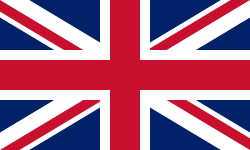
| |
| Proportion | 1:2 |
|---|---|
| Adopted | 1801 |
The Union Flag, commonly known as the Union Jack, is the Queen's badge flag or the flag of the United Kingdom,[1] and the flag for the Crown dependencies and British overseas territories. Before the dissolution of empire and the growth of individual national identities in the Commonwealth, the Union Flag was considered to be the flag of the Commonwealth.
The Union Flag continues to have an official or semi-official status in some Commonwealth realms; for example, it is known by law in Canada as the Royal Union Flag.[2] It provides an element in the individual flags of the British overseas territories and of several Commonwealth countries.
The current flag was created on 1 January 1801, at the union between the kingdoms of Great Britain and Ireland, to create one flag for the new United Kingdom of Great Britain and Ireland. It is of earlier origin however; the first union flag was created in 1606.
Origin
The Union Flag has its origin in 1603, when James VI of Scotland inherited the English and Irish thrones as King James I, thereby uniting the crowns of the three realms. On 12 April 1606, King James decreed a new flag to represent the union between England and Scotland, according to which the flag of England (a red cross on a white background, known as St George's Cross), and the flag of Scotland (a white saltire on a blue background, known as the Saltire or St Andrew's Cross), would be joined together, forming the flag of Great Britain and first union flag. Charles I later reserved that flag at sea for his own ships, but it became a national flag on 1 May 1707 when England and Scotland were united into one kingdom, Great Britain.
The current flag dates from the Union of Great Britain and Ireland which took effect on 1 January 1801.[3] The flag combines aspects of three national flags: the red cross of the red saltire of St Patrick, the white saltire of St Andrew and the red cross of St George.
Terminology
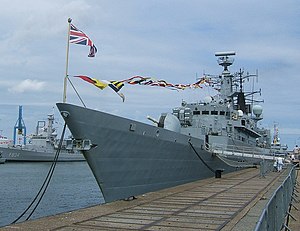
The terms Union Flag and Union Jack are both used for the flag. Whether to call it the "Union Flag" or the "Union Jack" is a matter of debate and although it is clear that in origin the flag is a "Union Jack" when flown at the jackstaff of a ship and a "Union Flag" at other times, the former has become the more common designation.
The Flag Institute use both names and note that:
It is often stated that the Union Flag should only be described as the Union Jack when flown in the bows of a warship, but this is a relatively recent idea. From early in its life the Admiralty itself frequently referred to the flag as the Union Jack, whatever its use, and in 1902 an Admiralty Circular announced that Their Lordships had decided that either name could be used officially. In 1908, a government minister stated, in response to a Parliamentary question, that "the Union Jack should be regarded as the National flag".[4]
At the first invention of the flag, in King James's proclamation of 1605, no name is given to the flag, ordered to be flown at the maintop of all ships of "our subjects of the Isle and Kingdom of Great Britain and the Members thereof". The first appearance of a name came later.
Union Flag
In King Charles's proclamation of 1634 the term "Union Flag" is used:
none of Our Subjects, of any of Our Nations and Kingdoms shall from henceforth presume to carry the Union Flag in the Main top, or other part of any of their Ships (that is) St Georges cross and St Andrew's Cross joined together upon pain of Our high displeasure, but that the same Union Flag be still reserved as an ornament proper for Our own Ships and Ships in Our immediate Service and Pay, and none other."[5]
On 1 January 1801, King George III issued a proclamation concerning the arms and flag of the United Kingdom of Great Britain and Ireland again calling it the "Union Flag":
And that the Union Flag shall be Azure, the Crosses Saltires of St. Andrew and St. Patrick Quarterly per Saltire, counterchanged Argent and Gules; the latter fimbriated of the Second, surmounted by the Cross of St. George of the Third, fimbriated as the Saltire : ...[6]—A Proclamation Declaring His Majesty's Pleasure concerning the Royal Style and Titles appertaining to the Imperial Crown of the United Kingdom of Great Britain and Ireland, and its Dependencies, and also the Ensigns, Armorial Flags, and Banners thereof"
Union Jack
Also in January 1801 King George III issued a proclamation concerning flags at sea, and this referred to "Our Flags, Jacks, and Pendants". The proclamation forbade merchant vessels from wearing "Our Jack, commonly called the Union Jack" nor any pendants or colours used by the King's ships.[7]
The same proclamation authorised a "red jack" to be used by privateers, which was of the same pattern as the red ensign.
The size and power of the Royal Navy across the Empire and the world in the 19th century could explain why the flag became known as the "Union Jack". Whatever its origin, the term "Union Jack" has long been in popular use beyond the jackstaff of a vessel and has provided many popular cultural references.
Design
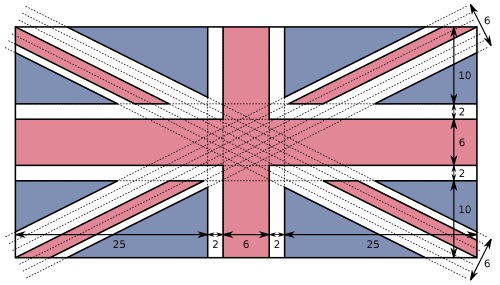
The Union Flag is normally twice as long as it is wide, a ratio of 1:2, which is the naval pattern. This 1:2 shape is followed by all derivative flags and has informed the shape of the flags of the Commonwealth. Other land flags though are normally a ratio of 3:5, according to the preference of the Garter King of Arms, and the Flag Institute have spoken in favour of displaying the Union flag in this pattern in place of the naval pattern; indeed in their Union Flag Bill presented to the House of Commons in 2008, they sought to change the specification to 3:5.
The Proclamation of 1801 which created the Union Flag contains no specification of size nor shape, nor the proportions or hues of the elements of the flag; these have grown up as matters of practice. The usual specifications adopted are:
- The red St George's Cross of a width is 1⁄5 of the flag's height, and each fimbration 1⁄15 of the flag height.
- The white St Andrew saltire of a width 1⁄15 of the flag's height, the broader white fimbration of 1⁄10 of the flag's height
- The red St Patrick saltire of a width 1⁄15 of the flag's height and the narrow white fimbration of 1⁄30 of the flag's height.
The standard colour specifications for the colours Union Flag (Royal) Blue, Union Flag Red and White. The Flag Institute give these as the following pantones:
| Colour | Pantone | RGB (Hex) |
|---|---|---|
| Red | 186 | CE1126 |
| White | FFFFFF | |
| Blue | 280 | 002B7F |
Flying
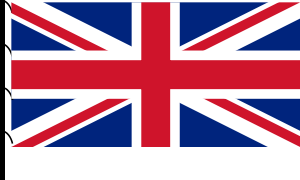 |
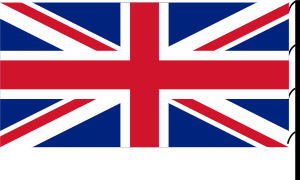 |
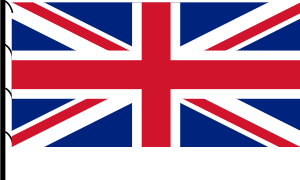 |
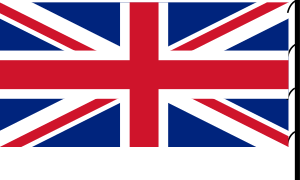 |
The flag does not have reflection symmetry as the saltires are counterchanged. The original specification of the Union Flag in the Royal Proclamation of 1 January 1801 did not contain a drawn pattern nor express which way the saltires should lie; they were simply "counterchanged" and the red saltire fimbrated, nevertheless, a convention was soon established which accords most closely with the description.
To fly the flag correctly, the white of the St Andrew is above the red of St Patrick in the upper hoist (the quarter at the top nearest to the flag-pole). This is expressed by the phrases wide white top and broad side up.
The first drawn pattern for the flag was in a parallel Proclamation of 1 January 1801 concerning civil naval ensigns, which drawing shows the red ensign (also to be used as a red jack by privateers). As it appears in the London Gazette, the broad stripe is at the top of the saltires on both sides, hoist and fly. That is not in accordance with the specification "counterchanged" as heraldry understands it.
It is often stated that a flag upside down is a form of distress signal or even a deliberate insult, though this seems to be a mischievous invention. In the case of the Union Flag, the difference is subtle and is easily missed by the uninformed. It is often displayed upside down inadvertently.
History
The First Union Flag of 1606
In 1603, James VI of Scotland inherited the English and Irish thrones (as James I), thereby [uniting the crowns of England, Scotland and Ireland in a personal union though they remained legally separate kingdoms. King James determined to establish a single flag for Great Britain combining those of England and Scotland and Lord Northampton, in charge of the English Admiralty, was set to work to determine a pattern. It is tempting to think that the Countess of Northampton, who was a Scot, chose the pattern. On 12 April 1606, King James decreed a new flag to represent this regal union of the "Isle and Kingdom of Great Britain":
By the King: Whereas, some differences hath arisen between Our subjects of South and North Britaine travelling by Seas, about the bearing of their Flagges: For the avoiding of all contentions hereafter. We have, with the advice of our Council, ordered: That from henceforth all our Subjects of this Isle and Kingdome of Great Britaine, and all our members thereof, shall beare in their main-toppe the Red Crosse, commonly called St George's Crosse, and the White Crosse, commonly called St Andrew’s Crosse, joyned together according to the forme made by our heralds, and sent by Us to our Admerall to be published to our Subjects: and in their fore-toppe our Subjects of South Britaine shall weare the Red Crosse onely as they were wont, and our Subjects of North Britaine in their fore-toppe the White Crosse onely as they were accustomed.
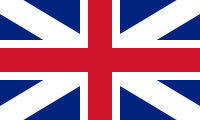
In 1634, King Charles I restricted the use of the Union Flag to the royal ships.[8]
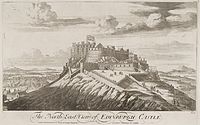
It appears that at some point during the seventeenth century a distinctive Scottish variant of the union flag arose, on which the white saltire overlaid the red cross. This design is described in the 1704 edition of The Present State of the Universe by John Beaumont, Junior, which contains as an appendix The Ensigns, Colours or Flags of the Ships at Sea: Belonging to The several Princes and States in the World.[9] On land, evidence suggesting use of this flag appears in the depiction of Edinburgh Castle by John Slezer, in his series of engravings entitled Theatrum Scotiae, c. 1693. Appearing in later editions of Theatrum Scotiae, the North East View engraving depicts the flag clearly.
Union, 1707
On 1 May 1707 the kingdoms of Scotland and England were no more; united as Great Britain. On 17 April 1707, just two weeks before the union took effect, Sir Henry St George, Garter King of Arms, presented to Queen Anne several designs for the new flag for the new kingdom and a flag was chosen. At the suggestion of the Scots representatives, the designs for consideration included that version of Union Flag showing the Cross of Saint Andrew uppermost; identified as being the "Scotts union flagg as said to be used by the Scotts". The Queen and her Council approved Sir Henry's original effort, numbered "one", which was the old Union Flag.
The original flag appears in the canton of the Commissioners' Ensign of the Northern Lighthouse Board. This is the only contemporary official use of the pre-1801 Union Flag in the United Kingdom and can be seen flying from their headquarters on George Street in Edinburgh.
The new flag from the Union of 1801
The current and second Union Flag dates from 1 January 1801 with the Act of Union 1800, which merged the Kingdom of Ireland and the Kingdom of Great Britain to form the United Kingdom of Great Britain and Ireland. The new design added a red saltire, the cross of St Patrick, for Ireland, counterchanged with the saltire of St Andrew.
Outside the Union flag, Saint Patrick's cross has seldom been used to represent Ireland, and with little popular recognition or enthusiasm; it is sometimes considered to derive from the arms of the powerful FitzGerald family rather than any association with the saint.[10] though other sources show an earlier connection.
The current flag's design, in use since 1801, is blazoned Azure, the Crosses Saltire of St Andrew and St Patrick, quarterly per saltire, counterchanged Argent and Gules, the latter fimbriated of the second, surmounted by the Cross of St George of the third, fimbriated as the saltire.
When the Anglo-Irish Treaty was concluded on 6 December 1921 and the creation of the new Irish Free State was an imminent prospect, the question arose as to whether the cross of Saint Patrick should remain in the Union Flag. The New York Times reported that on 22 January 1922:
At the College of Arms it was stated that certain modifications were under consideration and that if any action were taken it would be done by the King in Council. No parliamentary action would be necessary. Heraldry experts say that alterations in arms are very expensive. Some years ago there was a demand from Irish quarters that the blue ground of the golden harp on the royal standard should be changed to green. It was then estimated that the alteration would cost at least £2,000,000. To remove all reference to Ireland from the present Union Jack and Royal Arms would be vastly more expensive.[11]
There was some speculation on the matter in British dominions also, with one New Zealand paper reporting that:
...the removal of the cross of St. Patrick Cross after 120 years will transform the appearance of the flag. It will certainly become a flag under which great victories were won in the seventeenth and eighteenth centuries, but to most minds the sentimental loss will be great. Probably it will be found that the deletion is not absolutely necessary. Other possible changes include the abolition of the title of the United Kingdom, and the removal of the harp from the Royal Standard and the Coat of Arms, and the substitution of the Ulster emblem.[12]
However, the 1801 union was not dissolved and Northern Ireland remained loyal. In this regard, Sir James Craig, the Prime Minister of Northern Ireland remarked in December 1921 that he and his government were "glad to think that our decision will obviate the necessity of mutilating the Union Jack."[13] Ultimately, when the Home Secretary was asked on 7 December 1922 (the day after the Irish Free State was established) whether the Garter King-of-Arms would issue any regulations with reference to the Union flag, the response was no and the flag has never been changed.[14]
Use
At sea
The Union Flag is used as a jack by commissioned warships and submarines of the Royal Navy and by commissioned Army and Royal Air Force vessels. When at anchor or alongside, it is flown from the jackstaff at the bow of the ship. When a ship is underway, the Union Jack is only flown from the jackstaff when the ship is dressed for a special occasion, such as the Queen's official birthday.
The Union Flag is worn at the masthead of a ship to indicate the presence of the Sovereign or an Admiral of the Fleet.[15] It is also worn at the masthead of Her Majesty's Canadian ships within Canadian territorial waters on certain days of the year, such as the Queen's official birthday and Commonwealth Day.[16] The Union Flag may also be flown from the yardarm to indicate that a court-martial is in progress, though these are now normally held at shore establishments.
No other vessel is permitted to fly the union flag; the flagstaff of a vessel must instead bear an ensign derived from the flag; the white ensign for vessels of the Royal Navy, the red ensign for civil vessels and the blue ensign (which may bear a badge) for vessels in government service.
On land
No law has been passed making the Union Flag the national flag of the United Kingdom: it has become one through precedent. Its first recorded recognition as a national flag came in 1908, when it was stated in Parliament that "the Union Jack should be regarded as the National flag". In 1933 the Home Secretary, Sir John Gilmour also stated that "the Union Jack is the National Flag." Officially though the Union Flag is considered a flag of the monarch.
The Court of the Lord Lyon confirms that the Union Flag "is the correct flag for all citizens and corporate bodies of the United Kingdom to fly to demonstrate their loyalty and their nationality."[17]
Overseas territories
- Main article: Flags of the British Empire
All British overseas territories fly the Union Flag in some form and have flags which incorporate the Union Flag in the canton, with the exception of Gibraltar, though the Gibraltar government ensign does have it.
The Crown dependencies have their own flags, though their civil red ensigns and government ensigns do have the Union Flag in the canton.
The Commonwealth
At the close of the Great Canadian Flag Debate of 1964, which resulted in the adoption of the Maple Leaf Flag as Canada's national flag in 1965, the Parliament of Canada voted to make the Union Flag the symbol of Canada's membership of the Commonwealth and its allegiance to the crown. The move was a concession given to conservatives who preferred to keep the old flag, with its Union Flag in the canton. The Royal Union Flag (as it is now known in Canada) is flown alongside the Maple-Leaf Flag on Commonwealth Day and other royal occasions and anniversaries.[18]
In Australia, the current national flag gradually replaced the Union Flag. When it formally created the national flag in the Flags Act 1953, section 8 of that Act specified that "this Act does not affect the right or privilege of a person to fly the Union Jack." The Union Flag continued to be used for a period thereafter as a national flag.[19] The national flag of New Zealand was given official standing under the New Zealand Ensign Act in 1902, but similarly to Australia the Union Flag continued to be used in some contexts as a national flag.[20]
Outside links
| ("Wikimedia Commons" has material about Union Flag) |
- The Lyon Court: Flags
- British flags during The Protectorate and the Commonwealth of England
- British Monarchy — Union Flag
- BBC page for 400th anniversary of flag
References
- ↑ Union Jack - The British Monarchy website
- ↑ Canadian Heritage - Statement by the Hon Jason Kenney, PC, MP Secretary of State (Multiculturalism and Canadian Identity) on Commonwealth Day 10 March 2008
- ↑ British flags - the Flag Institute
- ↑ The Flag Institute: The Union Jack or The Union Flag?
- ↑ Proclamation appointing the Flag, as well for Our Navy Royal as for the Ships of Our Subjects of South and North Britain - 5 May 1634
- ↑ London Gazette: no. 15324, p. 2, 30 December 1800.
- ↑ "A Proclamation Declaring what Ensign or Colours shall be borne at Sea, in Merchant Ships or Vessels, belonging to any of His Majesty's Subjects of the United Kingdom London Gazette: no. 15329, p. 84, 17 January 1801.
- ↑ "Proclamation appointing the Flag, as well for our Navy Royal as for the Ships of our Subjects of South and North Britain", 5 May 1634.
- ↑ Beaumont, John (1704 – first published 1701)). The Present State of the Universe: Or an Account of I. The Rise, Births, Names, ... of All the Present Chief Princes of the World. .... Benj. Motte, and are to be sold by John Nutt, 1704. pp. 164.
- ↑ Hayes-McCoy, Gerard Anthony (1979). Pádraig Ó Snodaigh. ed. A history of Irish flags from earliest times. Dublin: Academy Press. p. 38. ISBN 0-906187-01-X.
- ↑ "May Alter The Union Jack". The New York Times (NYTimes.com). 14 January 1922. http://query.nytimes.com/mem/archive-free/pdf?res=9502EFDF1531EF33A25757C1A9679C946395D6CF. Retrieved 2012-01-09.
- ↑ "Signs of Heraldry". Ashburton Guardian, Volume XLII, Issue 9409 (National Library of New Zealand): p. 5. 13 December 1921. http://paperspast.natlib.govt.nz/cgi-bin/paperspast?a=d&cl=search&d=AG19211213.2.31.5&srpos=2&e=-------10--1----2%22Irish+Free+State%22-all. Retrieved 2012-01-09.
- ↑ "The Position of Ulster". Ashburton Guardian, Volume XLII, Issue 9413 (National Library of New Zealand): p. 5. 16 December 1921. http://paperspast.natlib.govt.nz/cgi-bin/paperspast?a=d&cl=search&d=AG19211216.2.25.5&srpos=14&e=-------10--11----2%22Irish+Free+State%22-all. Retrieved 2012-01-09.
- ↑ House of Commons Debate, 7 December 1922 (Vol. 159 cc2015-6W 2015W)
- ↑ "Use of the Union Flag at Sea". FOTW. 8 July 2011. http://flagspot.net/flags/gb-use2.html#sea. Retrieved 2012-01-09.
- ↑ "The Honours, Flags and Heritage Structure of the Canadian Forces" (pdf). Canada Department of National Defence. 4 January 1999. http://www.saskd.ca/heritage.pdf. Retrieved 2012-01-09.
- ↑ "The Union Flag". Court of Lord Lyon. http://www.lyon-court.com/lordlyon/218.183.html. Retrieved 2008-06-10.
- ↑ "The Royal Union flag (Union Jack)". Canadian Heritage. 17 November 2008. http://www.pch.gc.ca/pgm/ceem-cced/symbl/union-eng.cfm. Retrieved 2012-01-09.
- ↑ Kwan, Elizabeth (2006). Flag and Nation: Australians and their national flags since 1901. Sydney, Australia: University of New South Wales Press. ISBN 0-86840-567-1.
- ↑ "The New Zealand Flag" (pdf). Scouting New Zealand. http://www.scoutingtorlesse.org/Scouts/Resources/The_New_Zealand_Flag.pdf. Retrieved 2012-01-09.
Books
- Nick Groom (2007). The Union Jack: The Story of the British Flag. Atlantic Books. ISBN 978-1-84354-337-4.
